Warnaar Horstink Paintings
Warnaar Horstink was a Dutch artist and engraver, born in 1745 in the Netherlands. Horstink's period of activity was during the 18th and early 19th centuries, a time when art was experiencing shifts due to the influences of various art movements such as Neoclassicism and Romanticism. However, there is limited information available about Horstink's life and work, which may be due to the fact that he was not as widely recognized as some of his contemporaries.
Horstink's works primarily consisted of engravings, a form of printmaking where images are incised into a flat surface, typically metal, to make prints. Engraving was a popular technique during Horstink's time for reproducing images and was often used for illustrations in books and reproductions of paintings. Horstink would have been part of a community of artists and engravers who contributed to the dissemination of visual culture during the Enlightenment, when there was a high demand for printed images to accompany texts and for individual consumption.
Despite the scarcity of information about Warnaar Horstink's life and contributions to art, it is evident that he was a working artist during a pivotal moment in European art history. Horstink passed away in 1825, having experienced the artistic transitions of the late 18th century and the Napoleonic era. His works, like those of many artists of the period, might provide valuable insights into the aesthetic and technical aspects of printmaking of his time.


